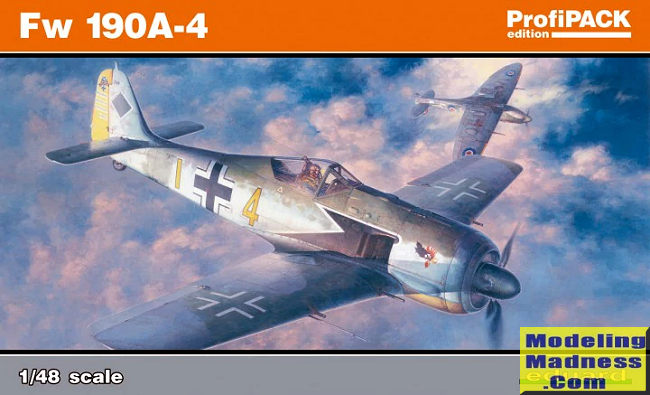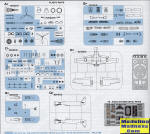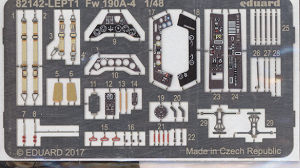
| KIT #: | 82142 |
| PRICE: | $39.99 on sale plus shipping |
| DECALS: | Five options |
| REVIEWER: | Scott Van Aken |
| NOTES: | 2017 release. Profipack |

| HISTORY |
Introduced in July 1942, the Fw 190 A-4 was equipped with the same engine and basic armament as the A-3. Updated radio gear, the FuG 16Z, was installed replacing the earlier FuG VIIa. A new, short "stub" vertical aerial mount was fitted to the top of the tail fin, a configuration which was kept through the rest of the production Fw 190s. In some instances, pilot-controllable engine cooling vents were fitted to the fuselage sides in place of the plain slots. Some A-4s were outfitted with a special Rüstsatz field conversion kit, comprising the fitting of a pair of under-wing Werfer-Granate 21 (BR 21) rocket mortars, and were designated Fw 190 A-4/R6. The most important innovation introduced by the A-4 was, however, the fitting of various Umrüst-Bausätze factory-refit packages.
The A-4/U1 was outfitted with an ETC 501 rack under the fuselage. All armament except for the MG 151 cannon was removed. The U3 was very similar to the U1, and later served as the prototype for the Fw 190 F-1 assault fighter. Some U3s used for night operations had a landing light mounted in the leading edge of the left wing-root. The U4 was a reconnaissance fighter, with two Rb 12.4 cameras in the rear fuselage and an EK 16 or Robot II gun camera. The U4 was equipped with fuselage-mounted 7.92 mm (.312 in) MG 17s and 20 mm MG 151 cannon. The U7 was a high-altitude fighter, easily identified by the compressor air intakes on either side of the cowling. Adolf Galland flew a U7 in the spring of 1943.
The A-4/U8 was the Jabo-Rei (Jagdbomber Reichweite, long-range fighter-bomber), adding a 300 L (80 US gal) drop tank under each wing, on VTr-Ju 87 racks with duralumin fairings produced by Weserflug, and a centerline bomb rack. The outer wing-mounted 20 mm MG FF/M cannon and the cowling-mounted 7.92 mm (.312 in) MG 17 were removed to save weight. The A-4/U8 served as the model for the Fw 190 G-1.
A new series of easier-to-install Rüstsatz field kits began to be produced in 1943. The first of these, the A-4/R1, was fitted with a FuG 16ZY radio set with a Morane "whip" aerial fitted under the port wing. These aircraft, called Leitjäger or Fighter Formation Leaders, could be tracked and directed from the ground via special R/T equipment called Y-Verfahren. More frequent use of this equipment was made from the A-5 onwards. The Fw 190A-4 could achieve 1,700 hp (2,100 with MW-50 boost). Its maximum speed was 670 km/h (420 mph) at 6,250 m (20,510 ft). Operational ceiling was 11,400 m (37,400 ft). Normal range was 800 km (500 mi). Normal takeoff weight was 3,800 kg (8,400 lb). A total of 976 A-4s were built between June 1942 and March 1943.
| THE KIT |
 It was only a matter of time before Eduard decided to produce
a series of 'short nose' FW-190As and so they started with the A-4, probably the
most built of these variants. This was apparently accomplished by adding a new
wing and fuselage sprue to extant sprues from their earlier kits. They also seem
to have learned a fairly valuable lesson from the earlier kits and that was to
limit the number of open panel features. Many modelers complained about poor fit
of these features and the inability to model the kits with the panels closed
without major work. In all honesty, the number of people who actually like kits
with all the panels open is fairly minimal. After hearing all the complaints from those who
built their A-8 version, for instance, I sold one of the two I bought.
It was only a matter of time before Eduard decided to produce
a series of 'short nose' FW-190As and so they started with the A-4, probably the
most built of these variants. This was apparently accomplished by adding a new
wing and fuselage sprue to extant sprues from their earlier kits. They also seem
to have learned a fairly valuable lesson from the earlier kits and that was to
limit the number of open panel features. Many modelers complained about poor fit
of these features and the inability to model the kits with the panels closed
without major work. In all honesty, the number of people who actually like kits
with all the panels open is fairly minimal. After hearing all the complaints from those who
built their A-8 version, for instance, I sold one of the two I bought.
Apparently this kit is still a bit on the fiddly side and once can tell that when looking over the instructions. However, reports from those who have built this kit for the first time are positive in terms of fit so I picked this one up. It isn't like I don't have any other 190A-4s in this scale, but I wanted to give this a go on my own.
 Typical of Profipack kits, this one includes a color photo
etch fret and canopy/wheel masks along with a number of decal options. You can
also use decals in place of some of the p.e. (such as the instrument panel and
side consoles. A goodly amount of the p.e. is used in the cockpit for throttles
and levers. The throttles will need to have small bits of stretched sprue added
to them. You also have a map case in p.e. as well as some placards and the
section between the control stick and rudder pedals. Pedals are also made of
this material as are the belts. Truthfully, once the cockpit is closed, even
with the canopy open, you won't see very much of this as the 190 cockpit opening
is quite small.
Typical of Profipack kits, this one includes a color photo
etch fret and canopy/wheel masks along with a number of decal options. You can
also use decals in place of some of the p.e. (such as the instrument panel and
side consoles. A goodly amount of the p.e. is used in the cockpit for throttles
and levers. The throttles will need to have small bits of stretched sprue added
to them. You also have a map case in p.e. as well as some placards and the
section between the control stick and rudder pedals. Pedals are also made of
this material as are the belts. Truthfully, once the cockpit is closed, even
with the canopy open, you won't see very much of this as the 190 cockpit opening
is quite small.
The engine is just the front face, which is fine as once the prop and fan are installed you won't see it. Wheel wells and the rear well/wing spar are separate items with a considerable number of items to go in the well. Unfortunately, it is designed such that you have to install the inner wing guns prior to closing the wing halves, making it easy to snap off the barrels while cleaning the seams or installing the wing.
Just to add to fiddly, there are two upper and one lower cowling panel to install and this kit has a separate instrument panel anti-glare section. All the control surfaces are separate and shown modeled in the neutral position. Landing gear is well done with separate hubs and wheels to aid painting. Note that these 190s have inner gear doors and in fact, these were used into the A-6 production before they were removed. Some units removed them in the field so check photos. Prop blades are one piece with the two piece hub. The back of the spinner is the engine fan. You are provided two canopies to use with one for the closed and one for the open option.
 Instructions are the usual color booklet with well drawn
construction steps and Gunze paint references. You would expect a huge decal
sheet with five options, but really, since all the insignia are the same for all
options, all the rest are unique markings. A separate sheet provides stencils.
Interestingly, the first profile shows the swastika while the rest are blanked
out. First option is S. Schnell's 9./JG 2 plane in January 1943. RLM 74/75/76
with light mottling, yellow ruder and lower cowling. His substantial victory
total is on the rudder. In a winter wash scheme is J. Trautloft's plane as CO of
JG54 in early 1943. This plane has yellow lower cowling, wing tips and fuselage
band with the latter going through the insignia. In RLM 79 over 76 is E.
Rudorffer's plane from December 1942 in Tunisia. White fuselage band and yellow
rudder. R. Eisele's plane when with 8./JG 2 in January 1943 has standard channel
front yellow lower cowling and rudder. The standard RLM 74/75/76 scheme has very
little mottling. Finally, W. Nowotny's plane with 1./JG 54 in March 1943 has a
locally applied scheme of dark green, brown and white over the standard scheme.
Eastern front ID markings. The decal sheet is well printed and you have a
stencil placement diagram as well.
Instructions are the usual color booklet with well drawn
construction steps and Gunze paint references. You would expect a huge decal
sheet with five options, but really, since all the insignia are the same for all
options, all the rest are unique markings. A separate sheet provides stencils.
Interestingly, the first profile shows the swastika while the rest are blanked
out. First option is S. Schnell's 9./JG 2 plane in January 1943. RLM 74/75/76
with light mottling, yellow ruder and lower cowling. His substantial victory
total is on the rudder. In a winter wash scheme is J. Trautloft's plane as CO of
JG54 in early 1943. This plane has yellow lower cowling, wing tips and fuselage
band with the latter going through the insignia. In RLM 79 over 76 is E.
Rudorffer's plane from December 1942 in Tunisia. White fuselage band and yellow
rudder. R. Eisele's plane when with 8./JG 2 in January 1943 has standard channel
front yellow lower cowling and rudder. The standard RLM 74/75/76 scheme has very
little mottling. Finally, W. Nowotny's plane with 1./JG 54 in March 1943 has a
locally applied scheme of dark green, brown and white over the standard scheme.
Eastern front ID markings. The decal sheet is well printed and you have a
stencil placement diagram as well.
| CONCLUSIONS |
Those who have built the earlier 190 kits and this one have commented that this one is an improvement in fit, but it is still a fairly fiddly build that requires the builder to pay attention to what they are doing. I guess one will only really know when the model is build. For those who want to add all the open panels provided by earlier kits, those are available in aftermarket from Eduard's family of brands.
Since this is a Profipack kit I expected there to be at least some resin bits in it for the $50 retail price, but there isn't. Unless one thinks that the p.e. fret, canopy masks, and additional markings options are worth $20 extra, the weekend edition may well be a better choice.
| REFERENCES |
https://en.wikipedia.org/wiki/List_of_Focke-Wulf_Fw_190_variants#A-4
May 2019
Copyright ModelingMadness.com. All rights reserved.
Thanks to
for the review kit. You can find this kit at your favorite hobby shop or on-line
retailer. If you would like your product reviewed fairly and
fairly quickly, please
contact
the editor or see other details in the
Note to
Contributors. Back to the Main Page
Back to the Review
Index Page
Back to the Previews Index Page